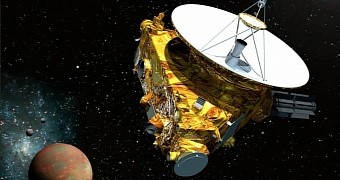Nearly a decade ago, NASA's New Horizons spacecraft embarked on a historical journey to Pluto. The probe launched on January 19, 2006, from the Cape Canaveral space station in Florida, US, and is expected to make its closest approach to its target celestial body later this year.
When this happens, the New Horizons spacecraft will officially become the first probe ever to get freakishly close to the Pluto system and study it in detail. The mission is expected to provide data concerning the makeup of this dwarf planet and the space environment around it.
New Horizons is already studying the Pluto system
Like all other spacecraft that have so far been sent to explore the anatomy of our Solar System, the New Horizons probe was asleep for the better part of its journey to its target. Specifically, the spacecraft spent a total of 1,873 days in hibernation mode.
The reason why the probe was made to take this seriously long nap was because the scientists behind this mission wanted to limit its use of electrical power, reduce wear and tear and cut back on the costs associated with operating it.
“Not only has hibernation reduced wear and tear on the spacecraft's electronics, it also lowered operations costs and freed up NASA Deep Space Network tracking and communication resources for other missions,” they explain in a statement.
True, the spacecraft woke up several times while traveling through space, but it was only on December 6, 2014, that NASA researchers irrevocably forced it out of its slumber. Thus, New Horizons' instruments are now studying the environment near Pluto's orbit.
Come January 25, the spacecraft's Long Range Reconnaissance Imager (LORRI) long focal length camera will get to work snapping dozens of images of the Pluto system. These images will serve to better determine Pluto's and satellite Charon's location in space and guide the probe towards them.
Soon enough, on July 14, the spacecraft is expected to successfully perform a flyby of the Pluto system. On this day, the New Horizons probe should come within just 7,700 miles (about 12,400 kilometers) of Pluto and buzz by it at a speed of about 31,000 miles per hour (nearly 50,000 kilometers per hour).
What scientists have so far learned about Pluto
Previous investigations have shown that Pluto holds plenty of nitrogen in its atmosphere. This gas is kept company by methane and carbon dioxide. Interestingly enough, evidence indicates that Pluto is no stranger to clouds, winds and even a mild greenhouse effect.
Charon, which is Pluto's largest moon, appears to have an atmosphere as well. The moon might have either siphoned this atmosphere off Pluto or birthed it on its own. A cometary impact could also explain the formation of an atmosphere on Charon, scientists say.
The New Horizons spacecraft will hopefully map the exact composition of Pluto's atmosphere and help scientists determine whether Charon has such as layer of gases coating it as well.

 14 DAY TRIAL //
14 DAY TRIAL //